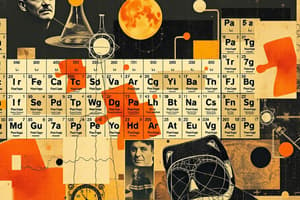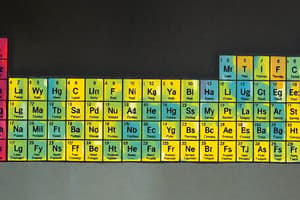Podcast
Questions and Answers
Which property of elements decreases as you move to the right in the Periodic Table?
Which property of elements decreases as you move to the right in the Periodic Table?
- Atomic size (correct)
- Electron affinity
- Metallic character
- Ionization energy
What tends to decrease as you move to the right in the Periodic Table?
What tends to decrease as you move to the right in the Periodic Table?
- Boiling point
- Electron affinity (correct)
- Metallic character
- Melting point
If an element has a unique electron configuration, what does this describe?
If an element has a unique electron configuration, what does this describe?
- Number of neutrons in the nucleus
- Atomic mass of the element
- Arrangement of electrons in atomic orbitals (correct)
- Number of protons in the nucleus
What trend is observed in atomic size as you move from top to bottom within a group in the Periodic Table?
What trend is observed in atomic size as you move from top to bottom within a group in the Periodic Table?
In which direction do melting and boiling points generally increase on the Periodic Table?
In which direction do melting and boiling points generally increase on the Periodic Table?
What happens to ionization energy as you move downwards in a period on the Periodic Table?
What happens to ionization energy as you move downwards in a period on the Periodic Table?
In which type of orbitals do transition metals have partially filled electrons?
In which type of orbitals do transition metals have partially filled electrons?
Why do transition metals form colored compounds?
Why do transition metals form colored compounds?
Which property decreases as you move to the right in the Periodic Table?
Which property decreases as you move to the right in the Periodic Table?
What trend is observed in metallic character as you move from top to bottom within a group?
What trend is observed in metallic character as you move from top to bottom within a group?
What increases as you move to the right in the Periodic Table?
What increases as you move to the right in the Periodic Table?
How does electron affinity generally change as you move from top to bottom within a group?
How does electron affinity generally change as you move from top to bottom within a group?
Flashcards are hidden until you start studying
Study Notes
Exploring the Periodic Table of Chemical Elements
The Periodic Table, a visual representation of the known elements and their properties, is a pivotal tool for chemists, enabling them to understand and predict the behavior of different substances. This exploration delves into the periodic trends, electron configurations, period properties, group properties, and transition metals as fundamental aspects of the Periodic Table.
Periodic Trends
The Periodic Table organizes elements based on their atomic number, the number of protons in their nucleus. As you move horizontally across the table (from left to right), you observe repetitive patterns in elements' properties, known as periodic trends. These patterns include:
- Atomic size: Atomic size decreases as you move to the right.
- Ionization energy: Ionization energy increases as you move to the right.
- Electron affinity: Electron affinity tends to decrease as you move to the right.
- Metallic character: Metallic character decreases as you move to the right.
- Melting and boiling points: Melting and boiling points generally increase as you move downwards.
Electron Configuration
Electron configuration is the arrangement of electrons in atomic orbitals for a specific element. Each element is characterized by a unique electron configuration, which describes the number of electrons in the s, p, d, and f orbitals. Electron configurations help chemists understand the periodic properties of elements and predict their chemical behavior.
Electron configurations are commonly written as abbreviated notations, such as 1s² 2s² 2p⁶ for Argon (Ar).
Period Properties
Each horizontal row in the Periodic Table represents a period. Period properties are the trends observed when moving from element to element in the same period.
- Atomic size: Atomic size increases as you move downwards.
- Ionization energy: Ionization energy decreases as you move downwards.
- Electron affinity: Electron affinity increases as you move downwards.
- Metallic character: Metallic character increases as you move downwards.
Group Properties
Each vertical column in the Periodic Table represents a group. Group properties are the trends observed when moving from element to element in the same group.
- Atomic size: Atomic size generally increases as you move from top to bottom within a group.
- Electron configuration: Electrons occupy higher energy orbitals as you move from top to bottom within a group.
- Ionization energy: Ionization energy generally increases as you move from top to bottom within a group.
- Electron affinity: Electron affinity generally decreases as you move from top to bottom within a group.
- Metallic character: Metallic character generally decreases as you move from top to bottom within a group.
Transition Metals
Transition metals, elements in groups 3 to 12, are uniquely characterized by their partially filled d orbitals. Transition metals exhibit a variety of chemical properties, such as:
- Formation of colored compounds: Transition metals form colored compounds due to the presence of d electrons in partially filled orbitals.
- Variable oxidation states: Transition metals often have more than one stable oxidation state due to the ability to lose or gain electrons from the d orbitals.
- Catalytic activity: Transition metals play a vital role in catalysis due to their ability to form metal-ligand complexes.
Understanding the periodic trends, electron configurations, period properties, group properties, and the unique behavior of transition metals enables chemists to predict and explain the properties and reactivity of chemical elements. This, in turn, aids in the development of new and innovative materials, technologies, and processes, shaping our world and advancing our understanding of chemistry.
Studying That Suits You
Use AI to generate personalized quizzes and flashcards to suit your learning preferences.




